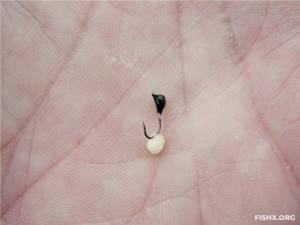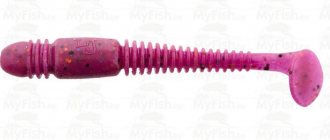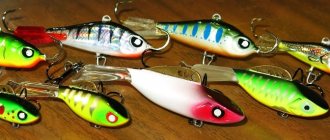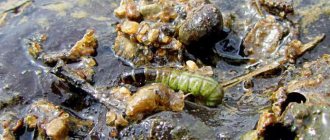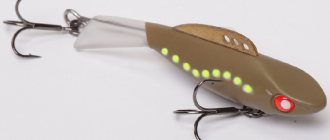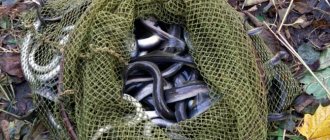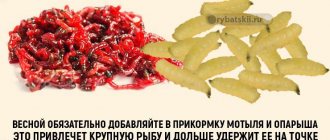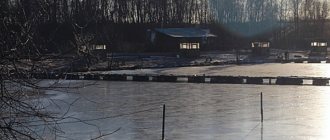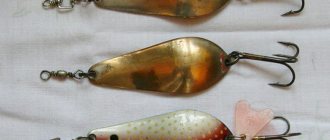general information
Kazara Dragonfly larvae (kazara)
are colored in brown-olive tones. Dragonfly eggs are laid in water or in the tissue of aquatic plants. The eggs hatch into larvae of an extremely characteristic shape, interesting in their biological characteristics. These larvae play an important role among other living material of freshwater excursions.
Dragonfly larvae are found everywhere in standing and slowly flowing water. Most often they are found on aquatic plants or on the bottom, where they sit motionless, sometimes moving slowly. There are species that burrow into mud. All larvae can be divided into three groups:
- Larvae of the rocker dragonfly type (Aeschna
) with an elongated body and a flat mask. This includes the largest species that are similar to each other. In the northern regions there are representatives of the genera: Gomphus - grandfather, Onychogomphus, Gordulegaster, etc. - Larvae of the common or true dragonfly (Libellula) type
with a shorter and wider body than the previous ones. The mask is helmet-shaped. They stay mainly at the bottom, often in a layer of silt. The following genera are typical for the northern regions: Libellula - true dragonfly, Cordulla - grandma, Leucorrhinia, Epitheca (Fig. 206), Sympetrum, etc. - Larvae of the lute type (Agrion)
with a very long elongated body, which has leaf-shaped gill plates at the rear end. We have representatives of the genera: Agrion - arrows, Lestes - lyutki, Erythromma (Fig. 207), Calopteryx - beauties, etc.
Dragonfly larva and its features
Kazara is a long insect with small legs and a relatively large head. It is considered the favorite delicacy of the striped robber. Many fishermen who go to the pond with children use a dragonfly larva as an attachment for a float rod. If the perch is within a radius of 5-10 meters from the bait, then the bite occurs instantly.
Manufacturers of silicone baits took into account the attraction of striped sailors to the geese, producing models as similar as possible to it. Today, many companies have similar baits in their lines, which differ from each other in shape, size and material density.
This is what the bait looks like, similar to the larva of a dragonfly (goose) of one of the famous
Read: Fishing with cheese
The first manufacturer to patent this kind of bait form is Fanatik. The model with the same name “Larva” immediately fell in love with both beginners and professionals.
The dragonfly larva helped out in any weather conditions, on completely different bodies of water and in different seasons. Such effectiveness forced many brands to release their analogues, which were able to compete with the original. Larva completely replicates the shape of a living insect. Due to the ribbed tail, the bait imitates the natural movements of the larva under water, provoking even a well-fed perch to attack.
The original forms of dragonfly larvae have the following advantages:
- high performance;
- efficiency in any conditions;
- low price;
- high material density;
- wide range of colors;
- Availability in different sizes.
Analog models did not stand still, improving the shape of products. Thus, larvae with twister tails, elongated models and, of course, centimeter-long nanojig baits were born.
Kazara lends itself to any jerky animation, since most aquatic organisms move in jerky movements. The best choice in the warmer months is double and single toss. You should always keep the jump length in mind. Short strokes do not raise the bait high, exploring the bottom more thoroughly. Dribbling gives good results in cold water. It completely repeats the movements used by anglers to animate the jig when fishing from ice.
Read: Catching grass carp. We use reeds
Description
When we are near bodies of water in the summer, we are all accustomed to seeing colorful dragonflies scurrying back and forth. This shy insect, which is almost impossible to catch with your hands, is often prey for fish that hunt in the surface layer of water. A dragonfly's habit of landing on twigs or lily pads that have fallen into the water, or simply a desire to fly too close to the surface, can be fatal. Bleak, chub, trout - all these fish are not averse to eating dragonflies. But few people know that much more often the victim of hungry fish is not the dragonfly itself, but its larva.
The larvae of each dragonfly species have their own unique shape. Frankly speaking, their appearance is not particularly pleasing to our eyes with beauty. Some of the dragonflies have creepy-looking nymphs - this is the scientific name for the larval stage of insect development. Traditionally, dragonfly larvae live and develop in reservoirs or parts of reservoirs with standing water, often silted, overgrown with aquatic vegetation, or swampy. Moreover, they easily survive both in completely fresh water bodies and in brackish ones. Depending on the species, nymphs can live burrowing deep into the muddy bottom, or move in the mud near the surface, or along the bottom itself, crawling along it with enviable leisureliness. Many species also live in thickets of aquatic vegetation, where it is easier for them to hide from external enemies. Depending on the habitat, the color of the nymphs varies - from yellow to almost black.
Description and lifestyle
Adult graceful dragonflies lay eggs on water, and larval development occurs in the water. They develop in bodies of water with stagnant or slowly flowing water. The appearance of the larvae has characteristic features.
The dragonfly larva has a narrow, elongated membranous body. There are no wings. The predominant color is brown, which is slightly diluted with gray shades. 3 pairs of legs of different lengths grow from the thoracic part. When viewed from above, one can detect a resemblance to an adult insect due to the bulging compound eyes. There is a mask at the bottom of the head. This organ is a paw bent at the joint, which is equipped with sharp hooks at the end. This is a modified lower lip. During the hunt, it straightens up in a split second, and then the caught prey is delivered to the mouth.
Dragonfly larvae are inactive. They can crawl clumsily and move with the help of the jet thrust created by the body. The larva is capable of taking water through the anus into the hindgut and throwing it out with great force to move. This explains the rapid movement of the larvae in the water, without visible swimming organs.
Interesting fact! The dragonfly larva is a voracious predator. It feeds exclusively on live prey.
It should be noted that the larva does not chase prey. She waits for her in ambush and captures her with a sharp release of her lower lip (mask). Favorite foods include mayfly and mosquito larvae.
Larvae (nymphs) molt periodically. With the beginning of the appearance of the rudiments of wings, they rise to the surface along the stems of aquatic vegetation. During this period, they become food for many species of peaceful and predatory fish.
Method of obtaining larvae
For prey, geese use a kind of “mormyshnitsa”. The device is a metal tube with a diameter of 15-20 cm and a length of 20-30 cm, one side of it is tightly welded and a mount for a wooden handle (like a shovel) is welded to it. The other side is cut slightly at an angle to the length, and holes with a diameter of about 1 cm are drilled in rows in the walls of the tube.
Dragonfly larvae are dug for fishing 1-3 days in advance. To do this, they look for banks with steep muddy ravine. The jig is stuck into such a bank, at a depth of 0.3-1 m under water, and then, filled with silt, it is raised to the surface. And at the water's edge, they pick out the silt with their hands, pouring water on it. In the silt, you can’t even see the larva, but when doused with water, it begins to flutter and is quickly transferred to a jar of water.
Dragonfly larva on winter fishing
Dragonfly larva on winter fishing
Is this phenomenon familiar - the fish refuses the traditional baits on the jig - bloodworms, maggots and, especially, a worm? This happens quite often, especially in the middle of winter, when there is a real lull in the reservoirs, called the dead winter by fishermen. What if you try to present the fish with something more “tasty”?
Surely in the summer everyone noticed places where thousands of dragonflies fly above the water, over the banks overgrown with tall grass. After mating, female dragonflies lay their eggs in water. From them the larvae emerge. The dragonfly larva is quite large. Its size depends on the type of dragonfly and can reach 3.5 cm - 4.5 cm. They are gray-greenish or dark brown in color, in the front part there are legs with which the larvae move along the bottom and crawl on aquatic plants. Dragonfly larvae are true predators that feed on the larvae of other insects. They also eat bloodworms in large quantities. I once had the imprudence to put in a box with bloodworms obtained from an ice hole, several dragonfly larvae that had ended up in a ladle for washing the sludge. It’s good that when I returned from the pond, I immediately opened the box and saw that part of the bloodworm had already been damaged by these voracious predators. All that was left of the bloodworm were empty “skins”, and the entire inside was sucked out. It is known that the goose even attacks tadpoles and fish fry. But the goose itself is a tasty food for most fish. It is not for nothing that it is in the grass that both peaceful fish and the predators that hunt them live. Roach, bream, silver bream, crucian carp, perch - they happily eat larvae, and even dragonflies themselves that fall into the water. In summer, catching dragonfly larvae for fishing is easy and simple. You just need to pull river algae ashore and collect the moving and therefore clearly visible larvae in a jar of water. However, it will not be possible to keep them alive for long, even if you constantly change the water. But for summer fishing there is no great need for this. You can always pull out a new bunch of grass and again collect the required amount. In winter, the best storage method is quick freezing in the refrigerator freezer. The larvae collected in the summer only need to be spread out in a thin layer in a plastic bag so that they do not touch each other, otherwise the larvae may be damaged. Thawing of the larvae occurs right while fishing, before they are placed on the hook of the jig. If you are not too lazy and go to a pond on the eve of fishing (to the “dragonfly” places spotted in the summer), make an ice hole there, scoop up the silt with the remains of aquatic vegetation from the bottom, then you can provide yourself with live dragonfly larvae and count on an excellent catch even during the lean period. It is excellent to catch both peaceful fish and perch using a jig with a dragonfly larva. It is only desirable that there be no ruff where the fishing takes place. Otherwise, all the work on obtaining and preserving dragonfly larvae will go down the drain. The ruff is also a big fan of this high-calorie food and will not fail to devour it before the larger fish for which this “delicacy” was prepared approaches. The dragonfly larva is usually attached to the hook from the head, but on small hooks you can also put them across the body, piercing them right in the middle. Playing with a jig with such a large attachment should be smooth with a large amplitude. Fish also bite well on a stationary jig with a dragonfly larva, since it is the appetizing bait itself that attracts it. Recently, very good artificial dragonfly larvae made from soft silicone have appeared on sale. They are quite realistic in appearance - they have legs like real larvae. But it’s still better to use natural bait, which is more to the fish’s taste.
Encyclopedia of fishing: https://vk.com/wall-23927120?q=larva
https://vk.com/ohota_i_rybalka#post-23927120_4162
Fishing with kazara
The most promising time for using goosefish as bait is from the beginning of June to the end of September. When fishing with a float rod, anglers who fish with maggots have a significantly larger catch than anglers who fish with dung worms or maggots.
When placing this bait on a hook, the hook tip is threaded through the body, starting from the head of the larva. You can start planting from the head. As you prefer. It is advisable to place several small larvae on one hook.
The larvae are great for catching ide, fairly large perch, silver bream, chub and many other fish.
How to increase your fish catch?
Over 7 years of active fishing, I have found dozens of ways to improve the bite. Here are the most effective ones:
- Bite activator. This pheromone additive attracts fish most strongly in cold and warm water. Discussion of the bite activator “Hungry Fish”.
- Increased gear sensitivity. Read the appropriate manuals for your specific type of gear.
- Pheromone-based lures.
Fly Selection
The advantage of flies over their live counterparts is their ease of use. This universal bait is suitable for both catching non-predatory fish and predators.
It also happens: How to catch dorado
All flies are divided into several types:
- dry (DryFlies);
- wet (WetFlies);
- nymphs;
- streamers;
- emergers;
- fantasy;
Dry flies resemble dragonflies, mayflies, flies, caddis flies, botflies, wasps and other insects that have fallen on the water. They are made in such a way that they do not sink in water and are designed for catching fish from its surface. They are held on the water by legs and a tail knitted from hard bird feathers. To make dry ones lighter, the hooks for them are made of thin wire. Until recently, all dry flies were tied in a fantasy style, which did not require resemblance to real insects.
With the advent of new synthetic materials, they are increasingly being manufactured in a super-realistic style, providing for the maximum imitation of living organisms. Dry flies are considered universal and are excellent for catching asp, bleak, chub, rudd, and roach.
Nymph
Wet flies are baits that look like drowned insects, small crustaceans, water beetles, leeches, tadpoles, as well as insect larvae developing in water. They are distinguished from dry flies by a very thin body, wings curved towards the bend of the hook, and the presence of legs and a tail. Wet flies are tied on a thicker hook.
This type of bait has proven itself well in fly fishing for grayling, salmon, and asp, but recently anglers have been using nymphs more often.
Nymphs are designed to imitate various insects at different stages of their underwater development from larva to pupa, which are part of the natural diet of grayling and trout. Because of this, almost all recent sport fishing competitions for these fish have been won thanks to nymphs. They are made in both fantasy and realistic styles.
The main requirements for such a bait are a clear imitation of the color of an insect for a specific body of water, the exact size and segmentation of the body, as well as a hook loaded with lead wire.
Streamers are similar to fry and are designed to catch large predators. This is the heaviest type of fly. The streamer hook is additionally equipped with tungsten or steel, which, when wired correctly, makes the bait look like a wounded fish.
Emerger
Emergers are a type of nymph that mimic an insect in its metamorphosis stage (between pupa and adult form). Grayling responds superbly to such bait, especially during the mayfly season. Independent tying of emergers has turned into a whole trend in fly making. There are even specialized clubs that unite craftsmen in this matter.
Fantasy flies are baits that have no prototypes in nature. Their size, color and shape can be anything.
They are divided into several types depending on the type of fish that is supposed to be caught:
- grayling;
- salmon;
- trout;
- asp;
- dace, etc.;
There is also such a type of flies as frame or decorative ones. They are knitted from expensive and exotic materials. Such flies are not used for fishing, but serve only as an exhibit at various collection exhibitions and knitting competitions.
Nowadays, spinning fishing is rapidly developing. The variety of different types of spinning is amazing: spinners, wobblers, jigs, twitching, trolling. More and more advanced specialized fishing rods are being produced, baits are constantly being improved, new promising types are being produced, and more and more catchy models are being produced. However, even today there are many fishermen who are attracted to catching pike with live bait. Moreover, such fishing is diverse and exciting.
It also happens: Fishing with a grasshopper - There are fish here
About live bait
Without leaving it until the end, let’s outline the range of fish species that are used as live bait for pike. Of course, the concept that pike needs to be caught on the type of fish that is its usual food source is correct, but at the same time there are interesting exceptions. So, live bait and their characteristics:
- Crucian carp.
The most popular live bait for fishing on a still body of water, pond, small lake or quarry. It is also used very often because it stores very well and withstands transportation. If stored properly, it can last all winter. - Roach.
This is the best live bait for river fishing. Due to the fact that roach can be easily caught in almost every river. Less crucian carp lives in the kana. You can also add rudd to the roach; fishing with live bait is similar in effectiveness. - Gudgeon.
Excellent live bait. Can be used both in still water and in currents. The slender body easily fits into the mouth of even a small bee-eater. - Perch.
Good live bait in the cold season, in the fall starting from October or November and in winter. Thanks to its prickliness, it masks sharp hooks; pike throws perch much less often than other fry. In summer it quickly dies even in a cage. - Bleak.
A good, fast-moving bait fish. The disadvantage is the same as that of the perch, it dies very quickly and must be baited very carefully, as it is easily injured. - Tall carp: sopa, silver bream, white bream.
They are less readily attacked by pike due to their width. - Rotan.
A recent immigrant from the Far East has become very popular with pike. It is well suited for fishing in autumn, October and November, as it becomes active at this time.
Fishing gear
Catching pike with live bait is carried out with various tackles. We list them in order of occurrence.
- Supply. Bottom tackle for fishing with live bait. It is a fishing line with a weight at the end and one or two leashes. Can be used with or without float. Used in open water, preferably in autumn or spring.
- Zherlitsa. Its summer version in the form of a flyer tied to a pole stuck into the bottom or shore appeared much later than the delivery, representing a kind of upgrade of the latter. They are caught in the spring, as well as in October and November during the feeding season.
- Circle. An advanced version of a floating delivery system. Modern anglers often use the ubiquitous plastic bottle as such.
- Live bait fishing rod. A variant of a fly fishing rod, or more often a Bologna fishing rod, with a large float capable of holding live bait on the surface and a sliding weight. Sometimes a live bait feeder is used in deep places in the reservoir. They are caught both on the river and in the lake, in the spring after the reservoir opens before spawning, as well as in October and November, when the water cools and becomes clearer.
- Winter perch or supply. Here is the widest field for fishing imagination. No other gear has as many options as winter rigs. There are a lot of ways to make such traps.
- Trap. This is not a tackle at all, but a replacement for a leash with a tee on a harness. Quite a disgusting poaching thing, I don’t even want to describe it.
Fishing with a stand
Catching pike with live bait using bottom gear is perhaps the most ancient method of hunting a predator, not counting the spear. The postavushka (or postavusha) is a strong fishing line or cord with a weight at the end, equipped with a pair of leashes with live bait attached to them. Casting the postavushka is done by hand.
Live bait is taken in one hand and a load in the other, after which a simultaneous movement of the hands is carried out towards the selected fishing point and the tackle is released. The free end of the fishing line is tied on the shore to a hammered stake, a tree trunk or a bunch of stems of growing reeds. In this case, it is necessary to leave a fishing line loop, which is released when biting and does not allow the pike to feel resistance.
Chernobyl larva
Larvae with this name live in the stems of wormwood, which is also called Chernobyl or Chernobyl because of its almost black stem. You can find a lot of this wormwood right by the river next to thickets of burdock and other weeds. Therefore, you can often see heaps of this wormwood with half-stalked stems on the ice. This means that the fisherman carefully cut the stems with a sharp knife and took out the larvae hidden there, and then put them in a separate bloodworm. It is not very easy to obtain Chernobyl larvae, since not every stem contains larvae. And how many more plants will you have to prepare, and then lose a lot of time searching for bait. But this work usually more than pays off when there is an excellent bite of roach, often large ones, despite the small size of the bait. You put a couple of larvae on the hook of a jig or attach them to a bloodworm - and you will often catch your neighbors to the envy of them. This often happens when fishing using these larvae, when the bite on bloodworms is weak.
